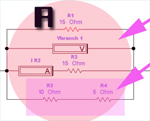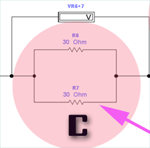|

Complex
circuits are solved by:
a) first finding the total resistance of branch
circuits
b) then adding them to get first total resistance
(RT) and then
total current (IT)
c) voltages around the circuit
are then easy to determine
VT = 120 V

Branch A
R3 and R4 are in
series, add them together to get the total resistance in the sub branch =
15 ohms
- now there are 3 equivalent resistors in parallel
(R1 , R2, and R3-4 )

or since all the parallel
loads are the same (15ohms) total resistance is 5 ohms


Branch B
R5 =
10

Branch C
R6 + R7 have a total
equivalent resistance of 15
because they are similar resistors
RT
The total circuit resistance
is equal to
RA + RB + RC = 5 + 10
+ 10 +
15 +
15 = 30
= 30
IT

To determine the currents and voltages
across each load can now be calculated ......
example : find the voltages and currents
across each load in branch A
Since we know the total current flowing through Branch A = IT =
4A then we find the voltage drop across each load in parallel

therefore R1 and R2 have
a voltage drop of 20v across each one (parallel)
The voltage drops across R3 and R4 (series) are
calculated in the following manner
> if the voltage across series resistors R3-4 is 20 volts then the
current is equal to VA/R3-4 = 20
V/ 15ohms = 1.33 A > VR3
the voltage across R3
= R3 x I3 = 10 ohms x 1.33A =
13.3 V
> VR4 the voltage across R4
can be calculated the same way or you can subtract 13.3V from 20V =
6.7V
|